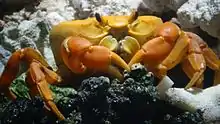Johngarthia oceanica
Johngarthia oceanica, also known as Clipperton crab, is a bright orange species of land crab that lives on Clipperton Island and on Socorro Island in the Revillagigedo Islands off Mexico in the tropical eastern Pacific.[1] Prior to 2019, J. oceanica was considered part of J. planata,[2][3] however a reexamination determined the land crabs on the oceanic islands to be a separate species. J. oceanica differs from J. planata in the shape of the mesial lobe of the infraorbital margin and the color of its carapace.[1]
| Johngarthia oceanica | |
|---|---|
 | |
| Scientific classification | |
| Kingdom: | |
| Phylum: | |
| Subphylum: | |
| Class: | |
| Order: | |
| Infraorder: | |
| Superfamily: | |
| Family: | |
| Genus: | |
| Species: | J. oceanica |
| Binomial name | |
| Johngarthia oceanica (Perger, 2019) | |
J. oceanica is omnivorous and feeds on seaweed (algae), vegetation and sometimes carrion. It has been observed climbing trees to feast on leaves.[4]
On Clipperton, the introduction of species that prey on the land crabs has had a significant impact on the island's vegetation. The introduction of pigs on Clipperton Island by guano miners in the 1890s reduced the crab population, which allowed grassland to gradually cover about 80 percent of the atoll's land surface.[5] The elimination of these pigs in 1958 caused most of this vegetation to disappear, resulting in the return of millions of crabs.[2][6] The introduction of ship rats from shipwrecks on the island in the late 20th/early 21st century has led to a decline in the crab population, causing a corresponding increase in both vegetation and coconut palms.[6]
Studies of predation upon land crabs on Socorro Island found that the crabs make up a significant portion of the yellow-crowned night herons's diet. Predation by red-tailed hawks and, to a limited degree, feral cats was also noted.[4]
References
- Notes
- Perger, Robert (2019-04-12). "A New Species of Johngarthia from Clipperton and Socorro Islands in the Eastern Pacific Ocean (Crustacea: Decapoda: Gecarcinidae)". Pacific Science. 73 (2): 285. doi:10.2984/73.2.9. ISSN 0030-8870. S2CID 146030476.
- Davie, P. (2015). Bieler R, Bouchet P, Gofas S, Marshall B, Rosenberg G, La Perna R, Neubauer TA, Sartori AF, Schneider S, Vos C, ter Poorten JJ, Taylor J, Dijkstra H, Finn J, Bank R, Neubert E, Moretzsohn F, Faber M, Houart R, Picton B, Garcia-Alvarez O (eds.). "Johngarthia planata (Stimpson, 1860)". MolluscaBase. World Register of Marine Species. Retrieved 22 February 2017.
- Robert Perger; Jorge Cortes & Cristian Pacheco (2013). "Closing a distributional gap of over 3000 km and encountering an invisible barrier: new presence/absence data for Johngarthia planata Stimpson, 1860 (Decapoda, Brachyura, Gecarcinidae) for Central America and biogeographic notes on East Pacific Gecarcinidae". Crustaceana. 86 (3): 268–277. doi:10.1163/15685403-00003172.
- Ortega-Rubio, Alfredo; Jímenez, María Luisa; Llinas, Jorge; Arnaud, Gustavo (1997). "Some Ecological Aspects of the Land Crab, Gecarcinus planatus Stimpson, at Socorro Island, Colima, Mexico". Journal of the Arizona-Nevada Academy of Science. 30 (1): 17–22. ISSN 0193-8509. JSTOR 40022435.
- Sachet, Marie-Hélène (1962). Geography and land ecology of Clipperton Island. Pacific Science Board, National Academy of Sciences-National Research Council.
- Pitman, Robert L.; Lisa T. Ballance; Charly Bost (2005). "Clipperton Island: pig sty, rat hole and booby prize" (PDF). Marine Ornithology. 33 (2): 193–194. Archived from the original (PDF) on 2020-11-19. Retrieved 2017-05-29.
External links
 Media related to Johngarthia oceanica at Wikimedia Commons
Media related to Johngarthia oceanica at Wikimedia Commons Data related to Johngarthia oceanica at Wikispecies
Data related to Johngarthia oceanica at Wikispecies